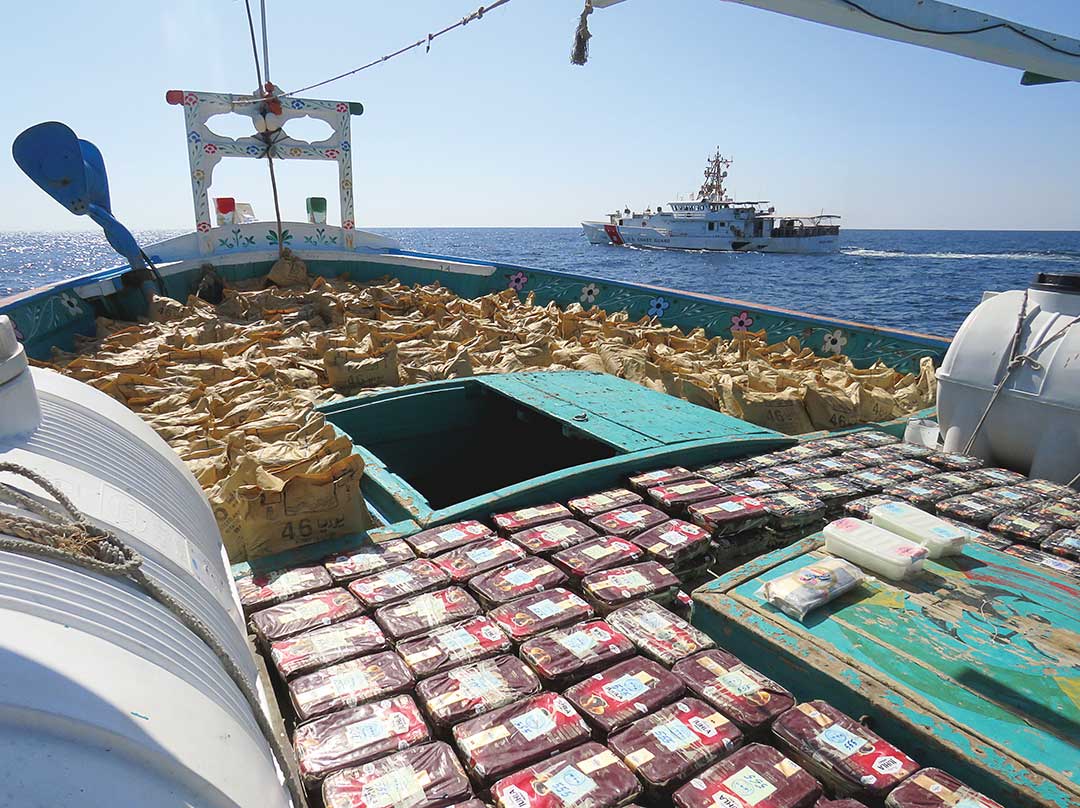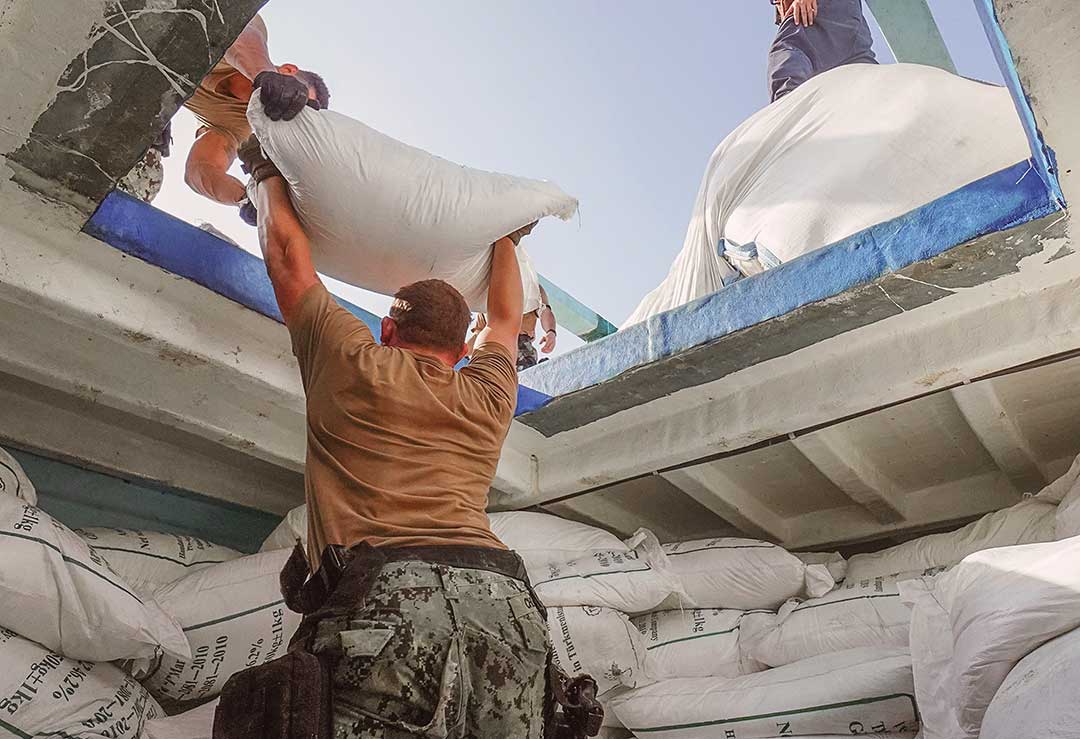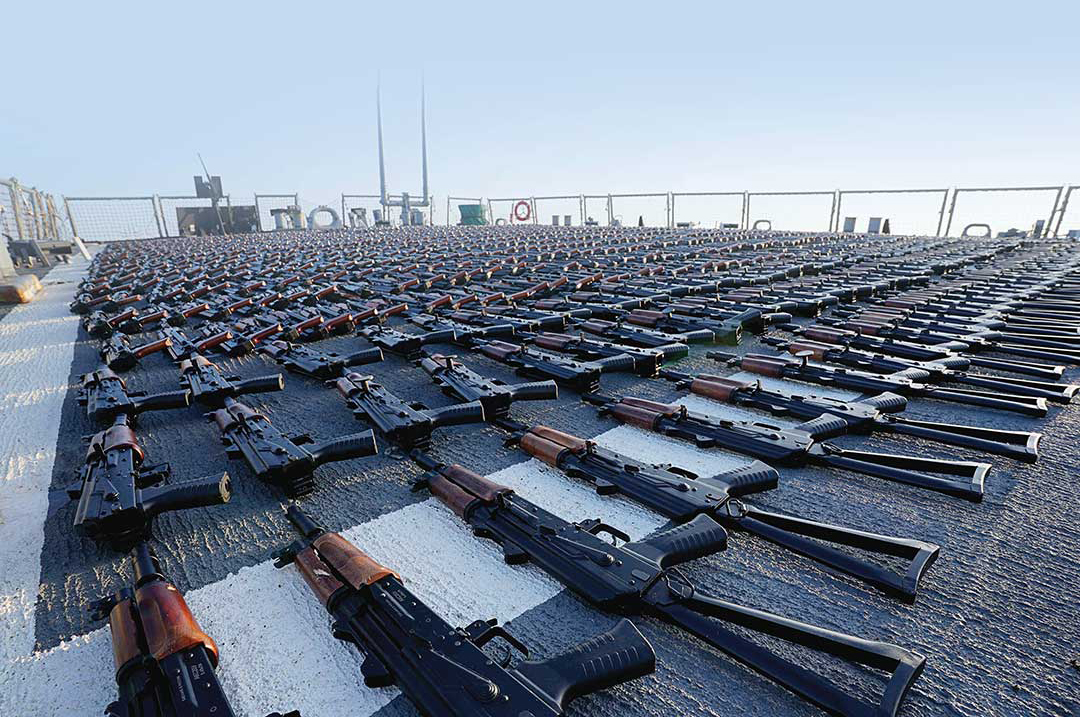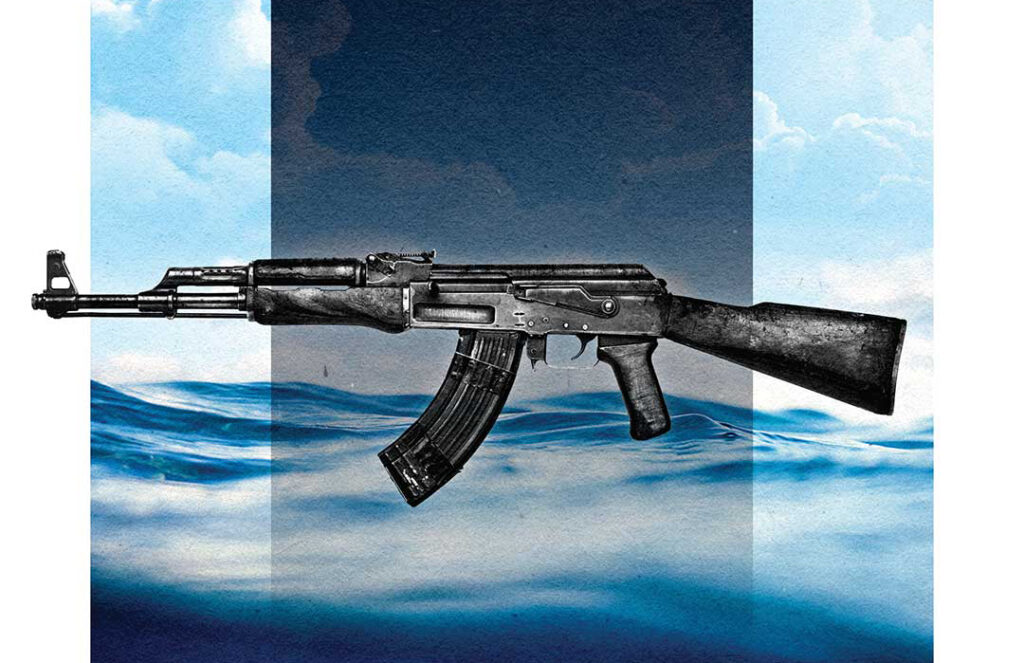MUAMMAR AL ERYANI, YEMENI MINISTER OF INFORMATION, CULTURE AND TOURISM
On November 8, 2022, a United States Navy ship and U.S. Coast Guard ship on their way to Yemen intercepted an Iranian ship carrying materials used to manufacture weapons. Investigators found 70 tons of ammonium chlorate used to make ballistic missile fuel and 100 tons of potentially explosive urea fertilizer.
In a statement, the U.S. military announced that the ship posed a threat to commercial navigation and the security of the region. It disposed of the cargo, sank the ship and handed its crew to Yemeni Coast Guard forces.
Threat to global energy supplies
This wasn’t the first time that such shipments had been intercepted. Since 2015, the U.S. Navy has captured several ships carrying weapons shipments and components for manufacturing ballistic missiles and drones. It was also announced in 2022 that a similar ship coming from Somalia carrying a shipment of urea, used in making explosives, was on its way to the Houthis.
Likewise, in April 2022, the British Royal Navy seized an Iranian ship loaded with missiles in the Gulf of Oman that was bound for the Houthis. By evaluating the contents of the ship, explosives experts were able to link it to the attack carried out by the Houthis in January 2022 on Abu Dhabi, the capital of the United Arab Emirates.
We have seen how in 2016 the Houthis fired missiles at the U.S. Navy near Bab al-Mandab, indiscriminately planted sea mines in Yemeni territorial waters, used a remote-controlled boat bomb to attack Mocha’s port in the Red Sea in 2017, and attacked Saudi ships in Hodeidah port in 2018.
There were also recent attacks on the ports of Al-Nashima in Shabwa and Al-Dhaba in Hadramout governorates, not to mention the targeting of an oil tanker in Qena oil terminal in Shabwa in October 2022.
We also discovered Iran targeting the oil tanker Pacific Zircon off the coast of Oman on November 16, 2022, with a bomb-laden drone, which led to minor damage to the hull of the tanker. It was an attempt to influence energy supplies in light of the crisis the world is experiencing, impose its conditions in negotiations to revive the nuclear deal and further its expansionist policies in the region.

Looming environmental catastrophe
In addition, we anticipate an environmental catastrophe from the Safer oil tanker moored in the Red Sea off the Yemeni coast. If the tanker continues to deteriorate, spilled oil could cost nearly $80 million to clean up. Since 2015, the Houthis have consistently denied United Nations technical teams access to assess damage to the Safer and initiate a plan of action.
It has become clear that the Houthis’ control of parts of Yemen with the support of Iran not only poses a threat to Yemen, but also to the safety of commercial ships and the security of international shipping lanes. The Houthis and their Iranian backers have violated all agreements — including the Stockholm Agreement and the U.N.-sponsored truce, all international laws, charters and Security Council resolutions — while undermining de-escalation and peace efforts.
As a result, the U.S. and British navies and other allied countries formed a new unit in April 2022 called Combined Task Force 153 to monitor the Red Sea, stabilize navigation and secure important international trade corridors through Bab al-Mandab, the Red Sea and the Gulf of Aden.
This has supplemented the active role already played by Saudi Arabia in leading the Arab Coalition, securing international shipping lanes in the Red Sea and Bab al-Mandab, and thwarting dozens of terrorist attacks planned by the Houthis over the past eight years involving remote-controlled explosives-laden boats and naval mines, all military techniques imported from Iran.
Importance of Strait of Hormuz
Since May 2022, several European countries, led by France, have been calling for the powers of the European Supervision Mission on the Strait of Hormuz — formed at the beginning of 2020 by eight European countries — to widen their reach to the Red Sea and the Indian Ocean through the Bab al-Mandab. The importance of this route lies in the fact that 10% of global trade passes through this strait, and it is expected to increase because of the Russia’s attack on Ukraine.
Since the outbreak of the Russian-Ukrainian war and the boycott of Russian oil, European countries have sought alternative sources from the Arabian Gulf region, the best alternative in terms of abundance and infrastructure. Furthermore, Italy and Germany have secured new deals with Qatar, and France has done the same with the UAE.
The matter is not limited to oil: There is cooperation between Europe and the Gulf states regarding clean energy as an extension of previous agreements on the use of hydrogen fuel between the European Union, Saudi Arabia and the UAE.

Maritime stability
Relations between East and West depend greatly on the stability of maritime navigation through the Strait of Hormuz and Bab al-Mandab due to their central geographical location as a junction between Europe, Asia and Africa. Many Western countries also depend on trade relations with the Arab region, especially the Gulf countries.
The world is facing a possible economic recession that has forced many superpowers to rethink their geopolitical orientation. Although the U.S. has decided to refocus some forces away from the Middle East, economic repercussions continue to highlight the need for stability in the region and Yemen. Several European countries are already engaged in a race to secure international trade lines and promote their leading role in maritime navigation in these crucial shipping lanes.
Economists predict the gross national product of the Red Sea region will be more than triple by 2050, from $1.8 trillion to $6.1 trillion. Despite this potential, economic forecasts based on current data indicate that investment in global trade security through the Arabian Gulf will not increase much during the coming decades due to the instability of the region. This could change dramatically if there are joint efforts to secure the region, particularly increasing the volume of global trade through the Red Sea and Bab al-Mandab to more than five times its current level, from $881 billion to $4.7 trillion by 2050.

Root causes
Despite these initiatives, the Western world is dealing with the symptoms of regional problems, not root causes. The simplest solution would be to adopt the strategy known as the upstream theory, which traces the symptoms back to the origin of the problem.
China is fully aware of the importance of this region. It is trying to extend its clout through its Belt and Road Initiative by investing in Djibouti, and implementing massive infrastructure projects there as it seeks to make inroads into Africa while specifically undermining the influence of the U.S.
Rather than launch more initiatives and expending millions and much effort in protecting commercial shipping lanes, concerned leaders — those in Europe in particular — should devote their efforts to supporting the Presidential Leadership Council and the legitimate government that represents the entire Yemeni political and social spectrum, enabling it to impose control and establish security and stability along the Yemeni coast.
At the same time, this would limit the Houthis and their military capabilities, which have recently been involved in the undeclared Iranian war on energy infrastructure, facilities, ports and oil tankers in international waters.

